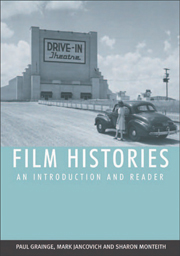Book contents
- Frontmatter
- Contents
- Preface
- Part I Film History from its Origins to 1945
- 1 The Emergence of Cinema
- 2 Organising Early Film Audiences
- 3 Nationalism, Trade and Market Domination
- 4 Establishing Classical Norms
- 5 The Age of the Dream Palace and the Rise of the Star System
- 6 Competing with Hollywood: National Film Industries outside Hollywood
- 7 The Rise of the Studios and the Coming of Sound
- 8 Realism, Nationalism and ‘Film Culture’
- 9 Adjustment, Depression and Regulation
- 10 Totalitarianism, Dictatorship and Propaganda
- 11 The Common People, Historical Drama and Preparations for War
- 12 Wartime, Unity and Alienation
- Part II Film History from 1946 to the Present
- Bibliography
- Copyright Acknowledgements
- Index
10 - Totalitarianism, Dictatorship and Propaganda
from Part I - Film History from its Origins to 1945
Published online by Cambridge University Press: 05 August 2013
- Frontmatter
- Contents
- Preface
- Part I Film History from its Origins to 1945
- 1 The Emergence of Cinema
- 2 Organising Early Film Audiences
- 3 Nationalism, Trade and Market Domination
- 4 Establishing Classical Norms
- 5 The Age of the Dream Palace and the Rise of the Star System
- 6 Competing with Hollywood: National Film Industries outside Hollywood
- 7 The Rise of the Studios and the Coming of Sound
- 8 Realism, Nationalism and ‘Film Culture’
- 9 Adjustment, Depression and Regulation
- 10 Totalitarianism, Dictatorship and Propaganda
- 11 The Common People, Historical Drama and Preparations for War
- 12 Wartime, Unity and Alienation
- Part II Film History from 1946 to the Present
- Bibliography
- Copyright Acknowledgements
- Index
Summary
If Hollywood managed to avoid regulation by state institutions through the use of the Hays Office, and the British documentary movement relied on state institutions, it is often suggested that in the totalitarian states of the 1930s – the Soviet Union, Nazi Germany, fascist Italy and the Japanese Empire – the cinema was no more than a crude form of state propaganda. Certainly these were not liberal states and overt opposition was not tolerated, but it would be equally wrong to see the films that were produced in these countries as simply propagandist.
Admittedly Soviet cinema had been state controlled since the revolution but in the 1930s there was a push to increase the number of films produced in the Soviet Union. The man placed in charge of this process was Boris Shumyatsky, who was anything but the stern propagandist. On the contrary, he was a champion of entertainment and opposed Soviet montage on the grounds that it was too difficult and intellectual. He therefore favoured a cinema that spoke more directly to popular competences and dispositions.
This did not mean that Soviet cinema was not subject to censorship and, from 1934, socialist realism was the approved style of filmmaking. However, this style of filmmaking is often caricatured by critics who want to present it as simple propagandist affirmation of Soviet society. It was supposed to present Soviet communism as representing historical progress, and as leading the world towards a socialist Utopia, but it was also associated with the rejection of the objective ‘documentation’ of reality.
- Type
- Chapter
- Information
- Film HistoriesAn Introduction and Reader, pp. 208 - 235Publisher: Edinburgh University PressPrint publication year: 2007



